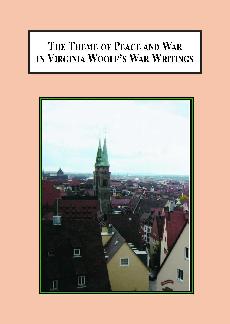This is our backup site. Click here to visit our main site at MellenPress.com
Theme of Peace and War in Virginia Woolf’s Writings: Essays in Her Political Philosophy

| Author: | Wood, Jane M. | |
| Year: | 2010 | |
| Pages: | 324 | |
| ISBN: | 0-7734-3857-2 978-0-7734-3857-6 | |
| Price: | $219.95 | |
This collection of essays examines how Virginia Woolf’s feminism, pacifism and understanding of war influenced her literary output on the topic.
Reviews
“What these essays share is a commitment to how Woolf’s understanding of war informs our own, their separate routes into Woolf’s war writings mapping new territory and offering alternate paths into those traveled before. What distinguishes each of them is a commitment to the manner in which different approaches to the war writings of Virginia Woolf suggest that she offers not one representation of a single war but many.” – Karen Levenback, Book Review Editor, Virginia Woolf Miscellany
“. . . a nice balance of theoretical and research-driven studies offering something of value to scholars, historians and researchers. value to scholars, historians and teachers. The essays are well written, thoughtful explorations of issues that must engage us all: violence and war, gender and oppression and an historical record that is as much myth as memory.” – Prof. James M. Haule, University of Texas
“This collection joins and advances a growing body of feminist responses to war, creating an argument rooted in 20th century history, but deeply necessary and applicable today.” – Prof. Barbara Bonnekessen, New Mexico Tech
“. . . a nice balance of theoretical and research-driven studies offering something of value to scholars, historians and researchers. value to scholars, historians and teachers. The essays are well written, thoughtful explorations of issues that must engage us all: violence and war, gender and oppression and an historical record that is as much myth as memory.” – Prof. James M. Haule, University of Texas
“This collection joins and advances a growing body of feminist responses to war, creating an argument rooted in 20th century history, but deeply necessary and applicable today.” – Prof. Barbara Bonnekessen, New Mexico Tech
Table of Contents
Acknowledgments
Introduction
Karen L. Levenback
PART ONE: WOOLF, WAR, AND GENDERED POLITICS
The Value of Three Guineas in the Twenty-First Century – Eileen Barrett, California State University, East Bay
Woolf and the War Machine – Gina Potts, Queen Mary, University of London
Writing as Unraveling: Woolf’s Gendered Decontruction of War – Lisa L. Coleman, Southeastern University
PART TWO: WOOLF, WAR, AND IMAGE
Photographing Violence: Three Guineas and Contemporary Feminist Responses to Images of War – Kimberly Engdahl Coates, Bowling Green State University
Virginia Woolf in the Age of Aerial Bombardment – Stuart N. Clarke, London, England
Mrs. Dalloway and the Art of Death: Monuments, Merchandise, and Memoirs – Danell Jones, Montana State University, Bozeman
PART THREE: WOOLF, WAR, AND TRAUMA
Pacifying Bloomsbury: Virginia Woolf, Julian Bell, and the Spanish Civil War – Emily Robins Sharpe, The Pennsylvania State University
Thinking Peace into Existence: Narrating Trauma and Mourning in Freud, Woolf, and Morrison – Noreen O’Connor, King’s College
What else can a gnat on a blade of grass do?: Thinking of War, Writing of Peace – Lolly Ockerstrom, Park University
PART FOUR: WOOLF, WAR, AND PEDAGOGY
The Echo Chambers of War in A Room of One’s Own and Three Guineas: Teaching the Interconnection of Gender Oppression and Endless Warfare – Vara Neverow, Southern Connecticut State University
Active Pacifism in a World at War: The Legacy of Virginia Woolf’s Pacifist Theory on Narrative Structure – Nancy Knowles, Eastern Oregon University
The Practical Wisdom of the “Educated Man’s Daughter”: Feminist Rhetorical Theory and Woolf’s Three Guineas – Kristen Garrison, Texas Woman’s University
Afterword by Jane M. Wood
Notes on the Contributors
Bibliography
Index
Introduction
Karen L. Levenback
PART ONE: WOOLF, WAR, AND GENDERED POLITICS
The Value of Three Guineas in the Twenty-First Century – Eileen Barrett, California State University, East Bay
Woolf and the War Machine – Gina Potts, Queen Mary, University of London
Writing as Unraveling: Woolf’s Gendered Decontruction of War – Lisa L. Coleman, Southeastern University
PART TWO: WOOLF, WAR, AND IMAGE
Photographing Violence: Three Guineas and Contemporary Feminist Responses to Images of War – Kimberly Engdahl Coates, Bowling Green State University
Virginia Woolf in the Age of Aerial Bombardment – Stuart N. Clarke, London, England
Mrs. Dalloway and the Art of Death: Monuments, Merchandise, and Memoirs – Danell Jones, Montana State University, Bozeman
PART THREE: WOOLF, WAR, AND TRAUMA
Pacifying Bloomsbury: Virginia Woolf, Julian Bell, and the Spanish Civil War – Emily Robins Sharpe, The Pennsylvania State University
Thinking Peace into Existence: Narrating Trauma and Mourning in Freud, Woolf, and Morrison – Noreen O’Connor, King’s College
What else can a gnat on a blade of grass do?: Thinking of War, Writing of Peace – Lolly Ockerstrom, Park University
PART FOUR: WOOLF, WAR, AND PEDAGOGY
The Echo Chambers of War in A Room of One’s Own and Three Guineas: Teaching the Interconnection of Gender Oppression and Endless Warfare – Vara Neverow, Southern Connecticut State University
Active Pacifism in a World at War: The Legacy of Virginia Woolf’s Pacifist Theory on Narrative Structure – Nancy Knowles, Eastern Oregon University
The Practical Wisdom of the “Educated Man’s Daughter”: Feminist Rhetorical Theory and Woolf’s Three Guineas – Kristen Garrison, Texas Woman’s University
Afterword by Jane M. Wood
Notes on the Contributors
Bibliography
Index
